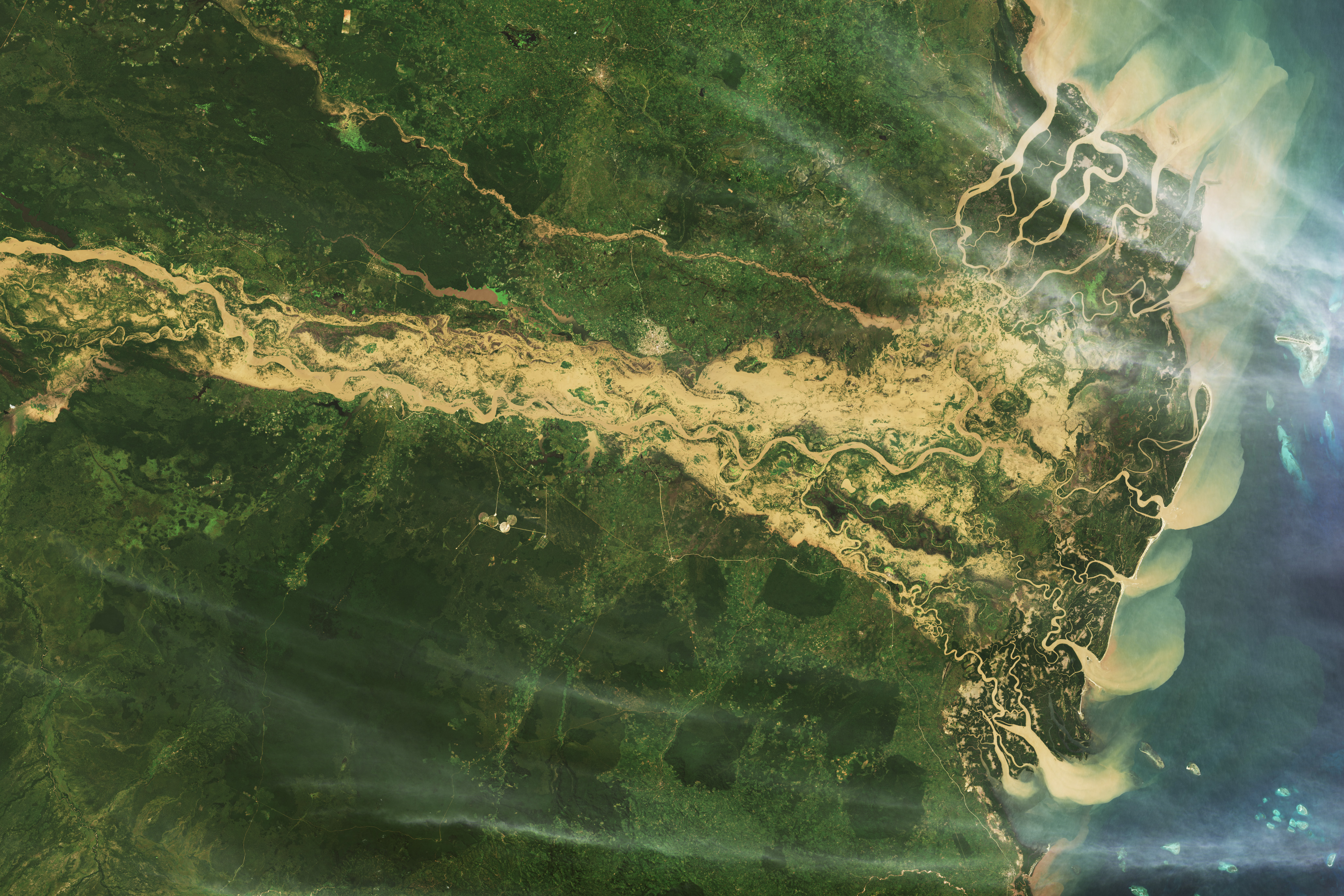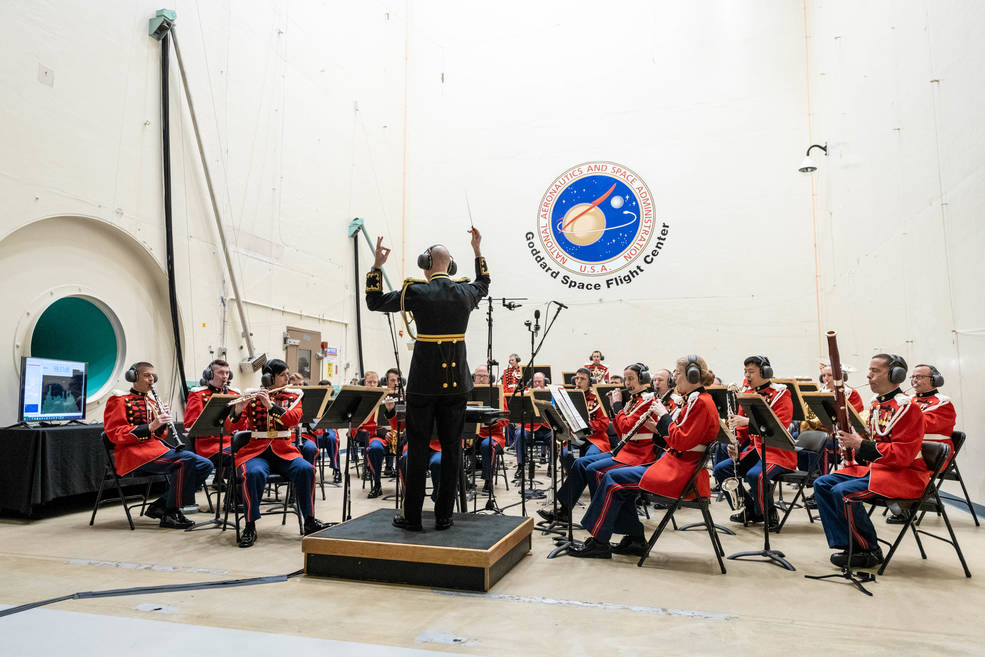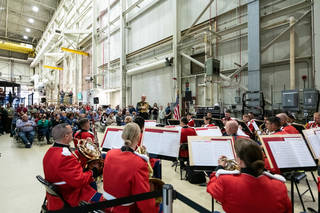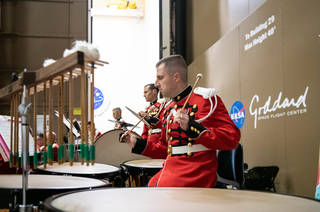NASA's upcoming PACE Earth science mission recently passed its acoustic test – a blast of noise to simulate the sound of a rocket launch – at the agency's Goddard Space Flight Center in Greenbelt, Maryland. But the PACE team wondered: Could musicians also produce the volume the test required? For the answer, they called on the U.S. Marines.
With a light flick of the conductor’s baton and a unified breath from each member, the band started playing the two deep and ominous notes easily recognized as the theme of “Jaws.” The sounds echoed off the walls of the acoustics chamber at NASA’s Goddard Space Flight Center in Greenbelt, Maryland.
Duunn dun… Duunn dun…
Something was different. The acoustics chamber isn’t like a concert hall, despite how its name might sound. Instead, the chamber replicates the harsh sound environment of a rocket launch by blasting sound waves at a spacecraft to make sure it can withstand the journey into orbit.
It’s an anxiety-inducing event for engineering teams. This spring, the Plankton, Aerosol, Cloud, and ocean Ecosystem (PACE) spacecraft was put to the test and passed, another step toward its launch in 2024 and its goal to study Earth’s oceans from space.
Duunn dun, duunn dun, duunn dun, duunn dun…
And just when you thought it was safe to go back in the acoustic chamber, the PACE team thought up a new trial. The mission team invited “The President’s Own” U.S. Marine Band to Goddard with a thrilling challenge: Could the musicians match the volume of the engineering test?
Dun dun dun dun dun dun dun.
Credits: NASA’s Goddard Space Flight Center
Download this video in HD formats from NASA Goddard’s Scientific Visualization Studio
The Scientific Method and a Performance to Remember
The challenge was the idea of Gary Davis, mission systems engineer at Goddard for the PACE mission. After connecting with Col. Jason Fettig, director of the Marine Band, they both were interested in putting the band to the test.
“I’ve been lucky enough to work on several missions here at Goddard, and whenever I saw those giant speakers, I wondered: How loud could I play an instrument if I were in there? How loud could a real band play?” Davis said. An amateur trombonist himself, Davis was invited to perform with the band during the acoustics tests as well.
Thirty-seven members of the band and Davis set up inside the chamber on May 3 to perform in an environment unlike any concert hall. (For the sake of this musical exercise – and to fit all of the musicians – the acoustics chamber was otherwise empty.) From the highest pitched piccolo to the lowest range of the tuba and everything in between, the band performed tunes such as John Williams’ “Star Wars” theme song and John Philip Sousa’s “The Stars and Stripes Forever.”
Later in the day, during a concert held just outside of the acoustics chamber, a note of excitement fizzed through the room when Fettig announced that the next song on the set list was one yet to be heard by the public. In fact, it would be a world premiere.
“The PACE Fanfare” is an original piece composed by Gunnery Sgt. Scott Ninmer specifically for the PACE mission. The lively melody evokes a sense of inspiration from the very start in the major tones of the trumpets.
“Hearing the director announce an original piece for PACE immediately sent shivers down my spine,” said Natasha Sadoff, applications deputy coordinator for the mission. “But the horns and then full band playing through it nearly brought tears to my eyes – pride in the mission and the PACE team that only music could capture.”
Inside the Acoustics Chamber
Given the nature of the acoustics chamber, the songs both sounded and felt different than if they had been played in a normal concert hall.
The acoustics chamber is made up of concrete walls and two massive speaker horns, about six feet tall, which can project sound at levels as high as 150 decibels, said Brian Ross, group lead for the structural dynamics test group at Goddard. These soundwaves bounce off the walls, hitting the spacecraft to imitate the range of vibrations from a launch. Imagine putting your hand up to a speaker at a concert and feeling the vibrations through your hand, though on a much larger scale for spacecraft tests.
During their performance of the “Jaws” theme, the band played at a volume of 116 decibels. The PACE test was completed at 138 decibels.
“To give you context, 140 decibels is the threshold of pain,” Ross said.
Members of the band discussed how even playing their instruments in that environment felt different. “I could feel the springs on my instrument vibrating,” said saxophonist Staff Sgt. Connor Mikula. “It’s like when you go to a concert, and you can feel the vibrations in your chest.”
Outside of the chamber, the audience members wore foam earplugs. All the performers wore specialized ear protective equipment because the band was going to reach extremely loud volumes that would also be amplified from being inside the chamber.
“With the earmuffs on, you can’t hear anyone around except the bass drum and the trumpets,” said clarinetist Gunnery Sgt. Lucia Disano. “But I could feel the vibrations in the instrument. The reed of the instrument vibrates when you play it, which is how it makes the sound, but I could feel my reed vibrating from the other sounds in the chamber.”
The U.S. Marine Band helped to contribute musical data for Davis’ informal experiment with volumes in acoustic chamber tests. But more importantly, the event underscored – and scored – the excitement around the PACE mission as it nears its launch date next year.
“The band was very inspirational and uplifting and I cannot thank them enough for taking the time to visit Goddard,” Davis said.
By Erica McNamee
NASA’s Goddard Space Flight Center, Greenbelt, Md.






























